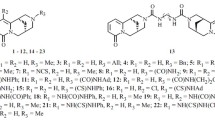Summary
(+)-Ptilocaulin, a novel cyclic guanidine extracted from the Caribbean sponge Ptilocaulis aff. P. Spiculifer, is reported to have broad spectrum antimicrobial activity in vitro as well as in vitro activity against L1210 murine leukemia. To more fully evaluate this compound as an anticancer agent, the in vitro cell growth inhibitory potencies of synthetic racemic ptilocaulin and ten clinical anticancer drugs were determined and compared in 16 different normal and transformed human and murine cell populations. Potency, expressed as the 50% inhibitory concentration (IC50), was determined by a tetrazolium reduction (MTT) assay. Ptilocaulin showed a fairly broad spectrum of in vitro activity against colon and mammary adenocarcinomas, melanomas, leukemias, transformed fibroblasts and normal lymphoid cells (IC50s 0.05- > 10 μg/ml). This activity was comparable to that of many of the clinical drugs, including vinca alkyloids, antibiotics, alkylators and antimetabolites. Cell viability was affected only after a 72 hr exposure to the compound. In a clonogenic assay, cytocidal effects were observed after 24–72 hr exposures to 10 × IC50 concentrations of ptilocaulin, as evidenced by failure of cells to resume growth after removal of the compound. Cytostatic effects were observed at ≤ IC50 concentrations, as evidenced by resumption of growth to near-control levels after removal of the compound. Ptilocaulin was toxic at 50 and 25 mg/kg in an in vivo L1210 tumor model and was ineffective at lower concentrations (T/Cs 100–112%). In vivo studies in a more sensitive tumor system are recommended but are limited by the lack of availability of sufficient quantities of the compound.
Similar content being viewed by others
References
Petitt GR, Day JF, Hartwell JL, Wood HB: Antineoplastic components of marine animals. Nature 227:962–963, 1970
Rinehart KL Jr, Shaw PD, Shield LS, Gloer JB, Harbour GC, Koker MES, Samain D, Schwartz RE, Tymiak AA, Weller DL, Carter GT, Munro MHG, Hughes Jr RG, Renis HE, Swynenberg EB, Stringfellow DA, Varva JJ, Coats JH, Zurenko GE, Kuentzel SL, Li LH, Bakus GJ, Brusca RC, Craft LL, Young DN, Connor JL: Marine natural products as sources of antivirial, antimicrobial and antineoplastic agents. Pure Appl Chem 53:795–817, 1981
Marderosian AD: Marine pharmaceuticals. J Pharm Sci 58:1–33, 1969
Nigrelli RF, Stempien Jr MF, Ruggieri GD, Liguori VR, Cecil JT: Substances of potential biomedical importance from marine organisms. Fed Proc 26:1197–1205, 1967
Sigel MM, Wellham LL, Lichter W, Dudeck LE, Gargus JL, Lucas AH: Anti cellular and anti tumor activity of extracts from tropical marine invertebrates. In Food-Drugs From the Sea Proceedings 1969 (Youngken HW Jr, ed). Washington, D.C., 1970, pp 281–294
Friess SL, Standaert FG, Whitcomb ER, Nigrelli RF, Chanley JD, Sobotka H: Some pharmacologic properties of Holothurin A, a glycosidic mixture from the sea cucumber. Ann NY Acad Sci 90:893–901, 1960
Schmeer MR, and Huala CV: Mercenene: in vivo effects of mollusk extracts on the sarcoma 180. Ann NY Acad Sci 118:605–610, 1965
Li CP, Prescott B, Jahnes WB: Antiviral activity of a fraction of abalone juice. Proc Soc Exp Biol Med 109:534–538, 1962
Harbour GC, Tymiak AA, Rinehart Jr KL, Shaw PD, Hughes Jr RG, Mizsak SA, Coats JH, Zurenko GE, Li LH, Kuentzel SL: Ptilocauun and isoptilocaulin, antimicrobial and cytotoxic cyclic guanidines from the Caribbean sponge Ptilocaulis aff. P. spiculifer (Lamarck, 1814). J Am Chem Soc 103:5604–5606, 1981
Roush WR, Walts AE: Total synthesis of (-)-ptilocaulin. J Am Chem Soc 106:721–723, 1984
Snider BB, Faith WC: Total synthesis of (±)- and (-)-ptilocaulin. J Am Chem Soc 106:1443–1445, 1984
Snider BB, Faith WC: The total synthesis of (±)-ptilocaulin. Tetrahedron Lett 24:861–864, 1983
Hassner A, Murthy KSK: Stereoselective synthesis of ptilocaulin and its 7-epimer. Tetrahedron Lett 27:1407–1410, 1986
Uyehara T, Furuta T, Kabasawa Y, Yamada J, Kato T: Total synthesis of (±)-ptilocaulin starting from tropolone. J Chem Soc Chem Commun 7:539–540, 1986
Walts AE, Roush WR: A stereorational total synthesis of (-)-ptilocaulin. Tetrahedron 41:3463–3478, 1985
Dexter DL, Spremulli EN, Fligiel Z, Barbosa JA, Vogel R, Van Voorhees A, Calabresi P: Heterogeneity of cancer cells from a single human colon carcinoma. Am J Med 71:949–956, 1981
Quinn LA, Woods LK, Merrick SB, Arabasz NM, Moore GE: Cytogenetic analysis of twelve human malignant melanoma cell lines. J Natl Cancer Inst 59:301–307, 1977
Nicolson GL: Cancer metastasis. Sci Am 240:66–67, 1979
Hilwig I, Gropp A: Staining of constitutive heterochromatin in mammalian chromosomes with a new fluorochrome. Exp Cell Res 75:122–126, 1972
Ruben RL, Neubauer RH: Semiautomated colorimetric assay for in vitro screening of anticancer compounds. Cancer Treat Rep 71:1141–1149, 1987
Ruben RL: Cell culture for testing anticancer compounds. In: Maramorosch K, (ed) Advances in Cell Culture, Vol. 6. Academic Press, New York, 1988, in press
Chen S-F, Ruben RL, Dexter DL: Mechanism of action of the novel anticancer agent 6-fluoro-2-(2′-fluoro-1,1′-biphenyl-4-yl)-3-methyl-4-quinolinecarboxylic acid sodium salt (NSC368390): inhibition of de novo pyrimidine nucleotide biosynthesis. Cancer Res 46:5014–5019, 1986
In Vivo Cancer Models, United States Department of Health and Human Services, NIH Publication 84-2635, 1984
Venditti JM, Wesley RA, Plowman J: Current NCI preclinical antitumor screening in vivo: results of tumor panel screening, 1976–1982, and future directions. Adv Pharmacol Chemother 20:1–20, 1984
Author information
Authors and Affiliations
Rights and permissions
About this article
Cite this article
Ruben, R.L., Snider, B.B., Hobbs, F.W. et al. Cytotoxicity of synthetic racemic ptilocaulin: A novel cyclic guanidine. Invest New Drugs 7, 147–154 (1989). https://doi.org/10.1007/BF00170851
Issue Date:
DOI: https://doi.org/10.1007/BF00170851




